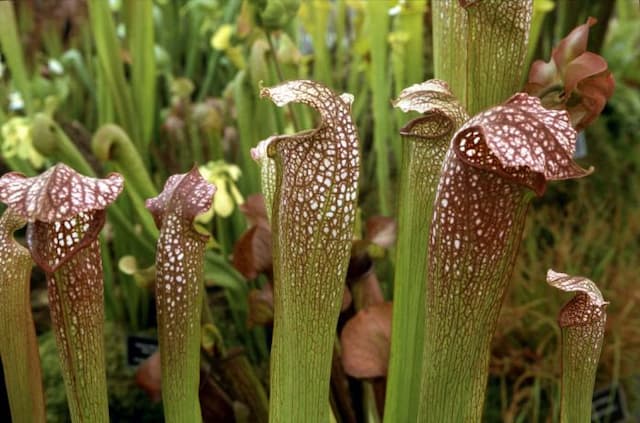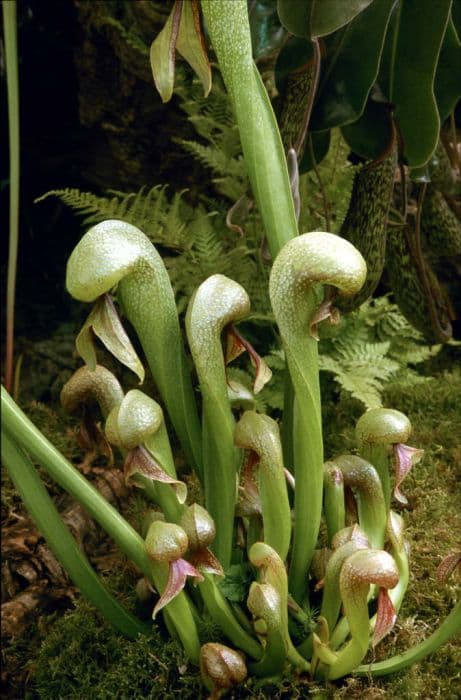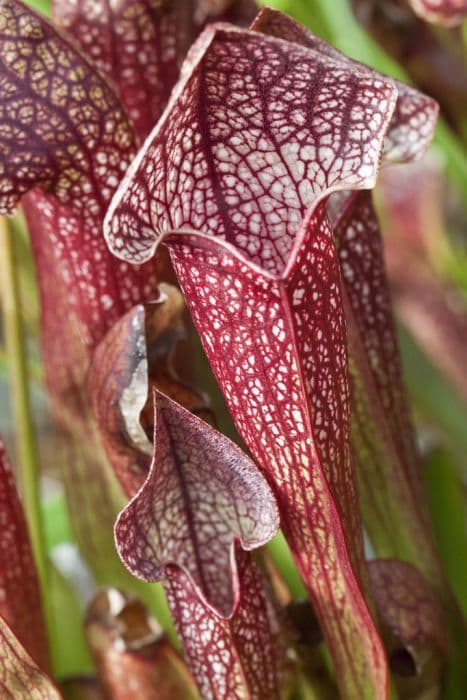Yellow Pitcher Plant Sarracenia flava var. rubricorpora 'Burgundy'

ABOUT
The Sarracenia flava var. rubricorpora 'Burgundy', commonly known as the Burgundy Pitcher Plant, sports a dramatic and captivating appearance. It features a series of elongated, tubular pitchers that are primarily used to trap and digest insects. These pitchers boast an attractive color palette, blending various shades of deep red and burgundy, which give this variety its name. The tints can be so intense that they may appear almost maroon under certain lighting conditions. At the top of each pitcher, there is a pronounced, hood-like structure known as a lid, which helps protect the inside of the pitcher from excess rainwater while still allowing entry to unsuspecting prey. This lid has a similar burgundy hue and is lined with delicate veins, which can create a contrasting pattern against the deep shades of red. The overall visual effect is one of richness and vibrancy. The plant's leaves, which evolve into the pitchers, wrap around to form a tube and are often adorned with fine, hair-like structures near the top. These contribute to the lead-in of insects towards the pitcher's opening. Inside, the surface of the pitcher is slippery, with downward-facing hairs, making escape difficult for trapped insects. During their blooming period, Burgundy Pitcher Plants produce flowers on tall stalks that rise above the pitchers. The blooms exhibit a pale yellow to chartreuse color, providing a striking contrast against the dark foliage. The flowers are umbrella-shaped, with multiple petals fanning out from a central point, adding a further ornamental quality to the plant. It should be noted that this description excludes specific measurements of the plant's features and dimensions.
About this plant
 Names
NamesFamily
Sarraceniaceae
Synonyms
Yellow Pitcher Plant, Trumpet Pitcher, Pale Pitcher Plant
Common names
Sarracenia flava var. rubricorpora 'Burgundy'
 Toxicity
ToxicityTo humans
Trumpet pitcher, the common name for Sarracenia flava var. rubricorpora 'Burgundy', does not have significant toxicity to humans. Generally, carnivorous plants like the trumpet pitcher are not considered toxic. However, it's always a good practice to avoid ingesting plants unless they are known to be edible, as individual reactions can vary.
To pets
Trumpet pitcher, the common name for Sarracenia flava var. rubricorpora 'Burgundy', is similarly not known to be toxic to pets. These carnivorous plants are not typically associated with poisoning in animals, and there is no evidence to suggest that the trumpet pitcher poses a significant risk if a pet were to ingest part of it. Nonetheless, it is always best to keep an eye on pets and prevent them from chewing on houseplants, as individual cases might differ, and to ensure the plants themselves are not damaged.
 Characteristics
CharacteristicsLife cycle
Perennials
Foliage type
Deciduous
Color of leaves
Varies
Flower color
Yellow
Height
2-3 feet (60-90 cm)
Spread
1-2 feet (30-60 cm)
Plant type
Herb
Hardiness zones
6
Native area
Southeastern United States
Benefits
 General Benefits
General Benefits- Attracts beneficial insects – Sarracenia flava, commonly known as the Yellow Pitcher Plant, lures and provides habitat for various beneficial insects which contribute to pollination.
- Controls pest populations – By trapping and digesting insects, it acts as a natural form of pest control, reducing the need for chemical insecticides.
- Enhances biodiversity – Its unique form and function contribute to the diversity of plant life within its ecosystem, supporting a wider range of species.
- Ornamental Value – The 'Burgundy' variety, with its striking red coloration, adds aesthetic value to gardens and collections.
- Educational interest – It can be used as a tool for education about carnivorous plants, plant adaptations, and ecological relationships.
- Conservation efforts – Cultivation of Sarracenia flava var. rubricorpora 'Burgundy' can help reduce the harvesting pressure on wild populations that are often threatened by habitat loss.
 Medical Properties
Medical PropertiesThis plant is not used for medical purposes.
 Air-purifying Qualities
Air-purifying QualitiesThis plant is not specifically known for air purifying qualities.
 Other Uses
Other Uses- Sarracenia flava, also known as the Yellow Pitcher Plant, can be used in carnivorous plant terrariums, adding an intriguing and often beautiful aesthetic to the setup while complementing other carnivorous species.
- Due to its unique appearance, the Yellow Pitcher Plant can be utilized as a natural art subject, inspiring artists and photographers who seek to capture the beauty of rare and unusual plants.
- The tall, tube-like structure of the Yellow Pitcher Plant makes it an interesting educational tool for biology teachers explaining plant adaptations and food chains in ecosystems.
- The plant can be a centerpiece in ecological gardens designed to showcase native plant species and support local wildlife, particularly in areas where it naturally occurs.
- Sarracenia flava can be used in rain gardens, where its natural preference for wet habitats helps manage excess rainfall and improves water quality by filtering runoff.
- In sustainability practice, the Yellow Pitcher Plant can be a living example when teaching about bog conservation and the importance of preserving natural habitats.
- The distinct pitcher shape of Sarracenia flava can inspire designers and inventors in creating biomimetic designs in architecture and product innovation.
- Yellow Pitcher Plant adds a unique feature to botanical exhibitions and garden shows, often attracting enthusiasts interested in carnivorous species.
- An unusual craft using Sarracenia flava involves creating highly detailed botanical illustrations for scientific publications, field guides, or artistic prints.
- The Yellow Pitcher Plant can serve as a conversation starter about biodiversity and the importance of plant conservation in nurseries and botanical gardens.
Interesting Facts
 Feng Shui
Feng ShuiThe Trumpet Pitcher Plant is not used in Feng Shui practice.
 Zodiac Sign Compitability
Zodiac Sign CompitabilityThe Trumpet Pitcher Plant is not used in astrology practice.
 Plant Symbolism
Plant Symbolism- Uniqueness: Sarracenia flava var. rubricorpora 'Burgundy', commonly known as the Yellow Pitcher Plant, displays unique coloring and shape, symbolizing the beauty found in being different and standing out.
- Adaptation: As a carnivorous plant that has adapted to thrive in nutrient-poor soils by consuming insects, the Yellow Pitcher Plant represents adaptability and resourcefulness.
- Attraction: The plant lures insects with its vibrant colors and nectar, symbolizing allure and seduction.
- Bewitchment: The way the Yellow Pitcher Plant entraps its prey symbolizes enchantment and the potential dangers hidden within seemingly beautiful things.
- Balance: This plant maintains a critical balance in its ecosystem, symbolizing equilibrium and interdependence in relationships and systems.
 Water
WaterThe Yellow Pitcher Plant should be watered thoroughly, allowing for excess water to drain away to prevent root rot. It prefers consistently moist soil, especially during the growing season in spring and summer. Water the plant with about 1 to 2 gallons of water every week, adjusting the frequency based on weather conditions and soil moisture levels. During the winter dormancy period, reduce watering but ensure the soil does not completely dry out. It's important not to let the plant sit in waterlogged conditions for extended periods.
 Light
LightThe Yellow Pitcher Plant thrives in bright, direct sunlight for optimal growth. It is best positioned in a spot where it can receive a minimum of six to eight hours of direct sunlight daily. However, it can tolerate some light shade in the hottest part of the day. Placing the plant in a south-facing window or an unobstructed outdoor space will satisfy its light requirements.
 Temperature
TemperatureThe Yellow Pitcher Plant does well in a range of temperatures; ideally keep it in conditions between 70°F and 90°F during the growing season. It can tolerate temperatures as low as 20°F in winter dormancy, but should not be exposed to prolonged freezing conditions. The plant benefits from a drop in temperature at night to around 50°F to 60°F.
 Pruning
PruningPruning the Yellow Pitcher Plant involves removing dead or damaged pitchers and leaves to promote new growth and prevent rot. Prune the plant in the early spring before new growth starts, cutting off any discolored or dead material. Pruning once a year is typically sufficient to maintain plant health and appearance. Always use clean, sharp tools when pruning to minimize damage to the plant.
 Cleaning
CleaningAs needed
 Soil
SoilFor the Yellow Pitcher Plant, a well-draining, nutrient-poor soil mix such as 1:1 peat moss to perlite is ideal. Maintain a soil pH of around 5.0 for optimal growth.
 Repotting
RepottingYellow Pitcher Plants need to be repotted every 2-3 years to refresh the soil and prevent root crowding.
 Humidity & Misting
Humidity & MistingThe Yellow Pitcher Plant thrives at high humidity levels, preferably 60-80% for healthy growth.
 Suitable locations
Suitable locationsIndoor
Use bright, indirect light, high humidity, and distilled water for indoor care.
Outdoor
Place in full sun, provide ample water, and ensure good air circulation.
Hardiness zone
6-8 USDA
 Life cycle
Life cycleSarracenia flava var. rubricorpora 'Burgundy', commonly known as the Yellow Pitcher Plant, begins its life cycle from a seed which germinates in warm, moist soil conditions. The seedling develops a small rosette of juvenile pitchers and photosynthetic leaves to perform photosynthesis and insect trapping for nutrients. As the plant matures, it produces larger, tubular pitchers with colorful veining and a sweet-smelling nectar to attract prey, facilitating further nutrient acquisition from the trapped insects. During the spring, the Yellow Pitcher Plant blooms with yellow, nodding flowers on tall scapes before the development of new pitchers. After the flowering stage, the plant focuses on vegetative growth and may produce offshoots or divisions, which can be separated to propagate new plants. The plant enters a dormancy period in the winter, where the pitchers and leaves die back, conserving energy to re-emerge in the following growing season.
 Propogation
PropogationPropogation time
Spring-Early Summer
One of the most popular methods of propagating the Yellow Pitcher Plant, specifically Sarracenia flava var. rubricorpora 'Burgundy', involves division. This type of propagation is best carried out in the early spring, just before the new growth begins. To propagate by division, the plant should be carefully lifted from its pot and the soil should be removed from the roots. Look for natural divisions in the rhizomes, and use a sharp, sterilized knife to separate them, making sure each division has at least one growth point. The new divisions can then be potted in a mix of peat and perlite or a carnivorous plant soil mix and kept moist until they establish new roots, usually over a period of weeks to several months.









